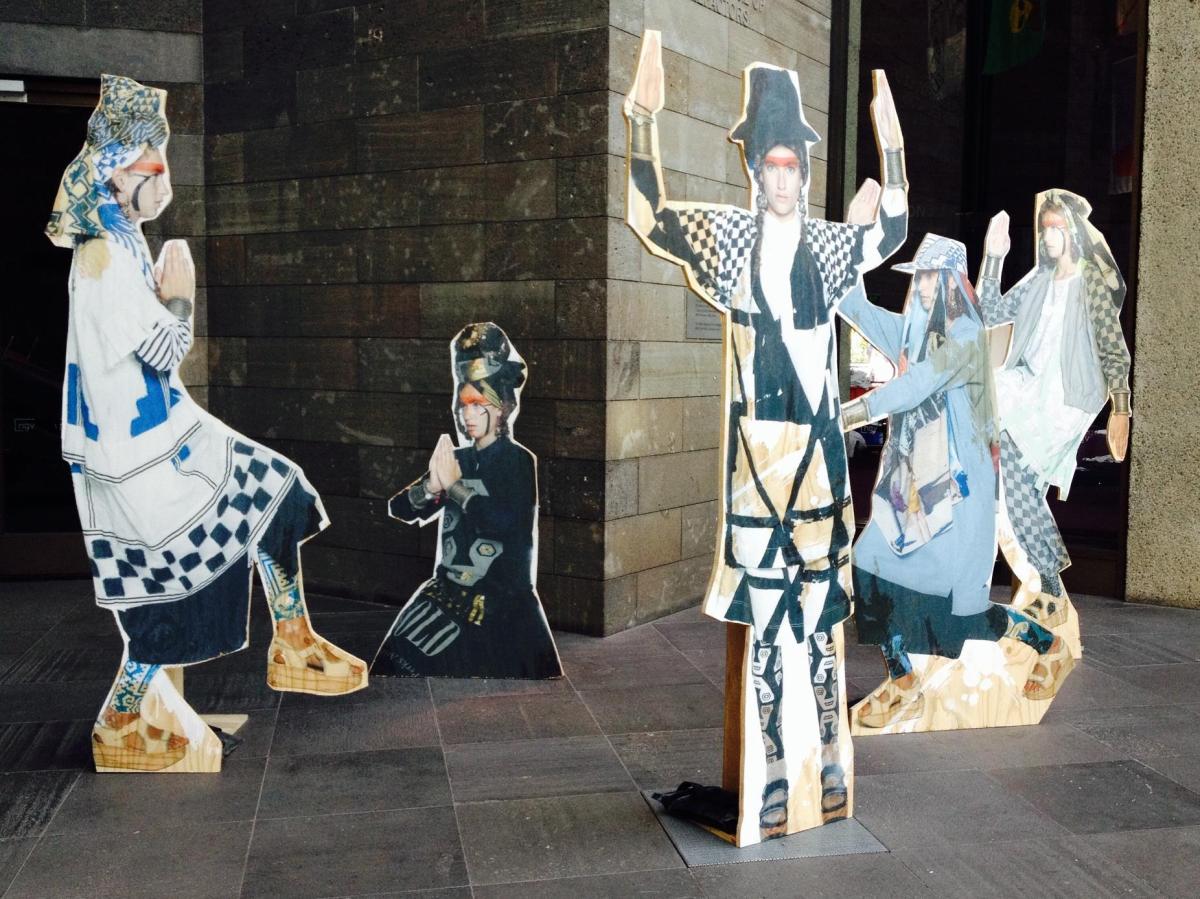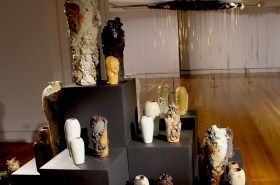‘Good artists copy; great artists steal,’ Picasso famously said. But between the good and the great, cultural appropriation is a messy business.
We see a lot of it in the music industry with artists picking out elements from different cultures and mashing them together: Selena Gomez’s bindi, Miley Cyrus’s twerk or Katy Perry’s geisha-style look for the AMAs.
But when artists engage with cultures outside their own, the appropriation can be offensive and damaging.
Melbourne-based fashion label Perks and Mini (PAM) has attracted criticism for its exhibits at the Melbourne Now exhibition at the National Gallery Victoria (NGV). The work, Black Gold, has wooden cut-outs of a women dressed in what seem to be African-inspired or Iindigenous garments replete with similarly-inspired eye makeup, headgear and jewellery. In the photo cut-outs the women are either gesticulating with their hands and arms or awkwardly balanced with one leg raised while their hands are folded in a namaste.
The exhibit has raised questions about whether PAM’s designers have the right to use symbols from cultures with which they have no personal connection. A video attacking the designers observes, ‘You might think they have some personal connection to the cultures which they have profited from but they are just as white as their $150 t-shirts.’
Cultural appropriation is sometimes attired as cultural exchange or appreciation and celebration of another culture, but the dark underbelly of cultural appropriation lies in the colonial tendency of mainstream western culture to dominate and patronise, and worst of all lend a voice to, and pretend to, represent a minority/non-mainstream culture.
Influences from other cultures are not new to art. Artists have been known to adopt and adapt elements, rhythms, patterns, instruments and such from different cultures that they have either known or experienced. Our food, for example, is the biggest example of cultural influences. Pasta originated as noodles in Asia and the all-American dish pizza, is of Italian origin. So when does all this borrowing start to become a problem? Why do certain groups of people get offended and hurt about this borrowing?
The problem lies in the denial of ownership and acknowledgement of origin when borrowing takes place in piecemeal, without any real connection or relevance to the represented culture. All this gets a little stickier when there is an existing power imbalance and years of suffering experienced by indigenous people all over the world at the hands of western/colonising cultures. Adopting symbols and patterns from indigenous cultures, or their iconography and characters without understanding their relevance offends people from these cultures.
When mainstream culture borrows from a minority culture to look cool and hip, or make a statement, it can come across as superficial and narrow. Culturally appropriated art forms often tend to align towards, and perpetuate the stereotypical representation of the culture they borrow from and nothing of value is added to this culture. There is no real ‘exchange’, so to speak. There is no taxonomic system to delineate the difference between cultural appropriation and cultural exchange. Context plays an important part in understanding the difference but more crucial is the power dynamic that flavours such an ‘exchange’. Who borrows from whom, and does this borrowing benefit the culture from which the said borrowing has taken place?
An open discussion at the Gertrude Contemporary in Fitzroy this week debated the issue of cultural appropriation in light of the NGV exhibits. The panel of speakers were Dianne Jones, a photo-media artist whose work deals with indigenous identity and cultural history, Dr Odette Kelada, lecturer in Australian Indigenous Studies the University of Melbourne and TextaQueen, a Melbourne-based artist exploring politics of sexuality, gender, race and identity. They deliberated and reflected on several western artistic practices appropriating non-western cultures from a colonial standpoint to continuing contemporary forms of cultural appropriation.
An important idea raised during the discussion was the role of curators who organise and bring together artists to present their work. The harm that cultural appropriation does is that it trivializes and fetishizes the culture from which it borrows. It undermines the efforts of artists from marginalised and Indigenous cultures who are trying to break away from the stereotypical images and representations of their own culture. It speaks poorly of curators and gallery managers by having art exhibits that reinforce or reinstate stereotypical ways of representing a certain culture in the same gallery which might have exhibits by an artist trying to challenge and question issues of identity, representation and authenticity of their own culture by another popular, mainstream culture. For example, artist Dianne Jones, who uses iconic photographs and paintings and superimposes her image in these to see an image of herself in photographs and paintings that define and symbolise the mainstream Australian culture.
So, what’s so wrong about cultural appropriation?
What’s wrong is the senseless borrowing of cultural artefacts, ideologies, symbols, colours, patterns etc in order to make one’s own artistic practice look cool, contemporary, rebellious, anti-establishment and of course, inclusive. When western artists care less about the history of the non-western culture they are borrowing from, they do exactly what their forefathers did two centuries ago when they pillaged and captured lands to suit their needs without even the slightest consideration towards the existing culture and people of the land.
In short, cultural appropriation is rehashed colonialism. Artists and curators, western and non-western need to be aware of art practices and the artists’ processes while creating and presenting a work of art. They need to be mindful of the amount of creative space given to artists who are really trying to say something through their art as opposed to those who might be rehashing and regurgitating a mishmash of cultural ideas and artefacts from ten different cultures.
The Melbourne Now exhibition is running at the NGV till 23 March, 2014.





